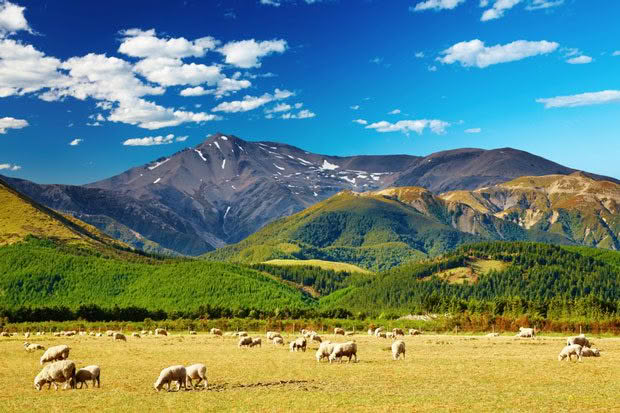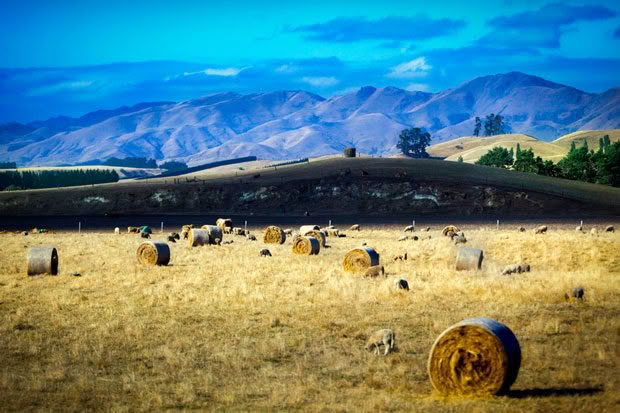12 summer pasture tips

Pasture management can be more like an art than a science. Try out these tips for helping you summer on the block and make hay while the sun is shining
WORDS: DR CLIVE DALTON
After what seemed to be a long winter and slow spring, summer can’t come soon enough. But on lifestyle blocks, where most folk have a full-time job off the farm, there’s a lot of planning to do during summer for school holidays, plus silage and hay making, weaning, sorting of livestock and much more.
We need rain in November to set the farm up for January and February, when it’s normal for things to dry off. Droughts in recent years should be a warning to make as much early silage as possible and then hay later, as you will need it for both a summer drought and a lack of feed through autumn and winter as pastures recover. Pasture management is a subject that always seems to be more art than science, and it’s even more difficult on a block as there are never enough paddocks to get a good grazing rotation going. It’s difficult to give pasture plants enough time to recover and build up bulk before they have to be grazed again.
Pasture is not like purchased feed in a bag. Grass and clover changes every day of the year, and even during the day, depending on the sunshine-making nutrients created by photosynthesis.
The basic principle is simple: pasture feeds stock, and stock control pasture to keep it in its nutritious green leafy stage, which is high in protein and energy, low in fibre and highly digestible. Pasture plants are hard-wired to grow fast to the seed head stage to reproduce, and then die back until the next season.
Pasture management’s aim is to stop or delay the plant from going to seed.
The ideal way to achieve this is to graze paddocks in rotation (rotational grazing). But the more usual practice is to ‘set stock’ where animals continually graze the same area so plants never get time to build up leaf area, and hence root reserves. This happens especially when paddocks are overstocked due to all the extra mouths to feed before young spring-born stock are weaned and sold off.
If you didn’t have a ‘spring flush’ on your farm, there are two simple reasons: too many stock and/or low soil fertility, and both need to be fixed. The ideal stocking rate is what you can carry through winter without them getting skinny. You don’t want them coming into spring in low body condition with no milk for their offspring. These animals will never get back into good body condition and are more prone to health problems like internal parasites.
If the grass is not growing, it’s tempting to apply a top dressing of nitrogen fertiliser (eg 25kg/ha of urea) to give what grass you have a boost. But this will be a short term gain only as the essential soil fertility components of phosphate, potash and sulphur will not be high enough. A soil test is needed first to check soil acidity (pH) and then P, K and S levels to see what fertiliser is needed to get them into the ideal range. There may also be serious trace element problems too. Pasture does not grow for free so any surplus should be saved as silage for the first option, because it preserves about 80-90% of the nutrients that were in the original pasture. Hay contains around 15-20%.
Silage is really pickled pasture, using lactic and acetic acid as the natural preservatives, and it’s the best option for the first surplus pasture. The best time to cut silage is when about 10-15% seed heads are showing. This can happen quickly after only a few warm days, so have your contractor organised months beforehand, and get regular updates on how things are going for them. November is too early to think about making hay, as pastures need to be more mature so that’s an after-Christmas option in most areas.
But silage is a problem for block owners because most of today’s contractors can only offer large wrapped bales which are difficult to move and feed out. If bales are left in a paddock for stock to feed from ad lib, the result is a burned and pugged area of grass, which is slow to recover, and often a lot of wasted silage too. A few contractors will wrap small bales, which inevitably are more expensive and still a two-person lift. Machines that make small bales are getting old and are kept going by parts from other old balers so eventually this won’t be an option anyway.

Make hay while the sun is shining.
But whatever size bales are made, they need to be well wrapped to keep out air, protected from damage by birds and rats, and well fenced from stock. Even the smallest puncture will let in enough air to cause mould, and mouldy silage (or hay) should never be fed to livestock. Mould is also a human health hazard so be careful not to breathe it in. Be wary about ‘balage’ as it can either be silage made from pasture gone to seed, and therefore lacking in nutrition, or wrapped hay that got wet (again lacking in nutrition), it’s hard to compress, and it could be full of weeds and mould.
In theory, balage is about 40% Dry Matter (DM), whereas good silage is around 20% and hay is 80%. Remember that it’s not the DM, which is a measure of feed quality, but the nutrients (protein and energy) in the DM which is important. You will see this expressed as ‘Metabolisable Energy’ or ME and in good quality feeds it’s around 11-12.
Good hay should be green and leafy, smell sweet, and not have been rained on. Hay made from pasture that has ‘died on its feet’ before cutting is of little nutritional value. The chances are that it’s mainly Yorkshire fog or browntop which are low quality grasses. If grass has really got out of control and gone to seed, and making supplements is too difficult or expensive, a simple option is to buy or borrow some big mature cattle and keep them moving around the farm to eat off the tops as fast as possible which should stimulate some new green re-growth. They’ll tend to be quieter and more respectful of fences. Sell them again as soon as they have done their job.
Young stock are not suitable to chew off rank pasture, as it’s important not to leave clumps which will keep on growing into bigger clumps. A big problem can be cocksfoot in pasture which becomes more unpalatable as it ages. There will always be long grass around dung patches, but these should be grazed next time around which big cattle will do.
You have to be tough when using cattle as grazing machines to clean up rank feed, as they’ll expect a fence shift every time they see you. Keep out of sight so you don’t set them off mooing, and move them tomorrow.
When pasture gets really long and falls over, cattle will trample a lot of it into the ground. This is an awful waste but you’ll have to accept this and wait until it rots and the new grass grows up through it. At least this retains soil moisture, although it looks awful. However, it’s a bad situation for clover plants which need space and light to grow, so it’s best to avoid this situation in future by taking action earlier. When things get really dry, don’t get on the tractor or ride-on mower to slash off any surplus dead pasture, just to have a ‘tidy up’. This will just expose more soil area to the sun and it will dry out even quicker, plus you risk encouraging the growth of the spores that will cause facial eczema (FE) from January-May.
12 SUMMER PASTURE TIPS
• Check arrangements well ahead of time with your silage/hay contractor, and pay accounts promptly.
• Organise silage making as soon as you see a pasture surplus forming, when 15% of seed heads appear.
• Check your paddocks are free from rubbish which can damage machinery, that water troughs are turned off and that gates can be opened wide.
• Keep kids and pets away from machinery.
• Don’t skimp on bale wrap, and protect bales from stock and vermin.
• Don’t make hay until pastures are more mature and the weather is more settled.
• If you don’t want to make silage or hay, rotate large cattle quickly around paddocks to eat off the surplus and allow regrowth.
• Buying silage or hay bales off the paddock is the best buy.
• Be wary of baleage and never buy any without opening a test bale to see what’s inside.
• Leave the slasher in the shed.
• Don’t apply fertiliser in summer when things have dried out – leave it until autumn.
• Use tree prunings for stock feed in dry spells, and plant more fodder trees for future use.
• Check that any surplus plant material fed to stock is not toxic – if you don’t know what it is, don’t feed it out as toxic plants are more palatable when wilted.
READ MORE:
Love this story? Subscribe now!
 This article first appeared in NZ Lifestyle Block Magazine.
This article first appeared in NZ Lifestyle Block Magazine.
